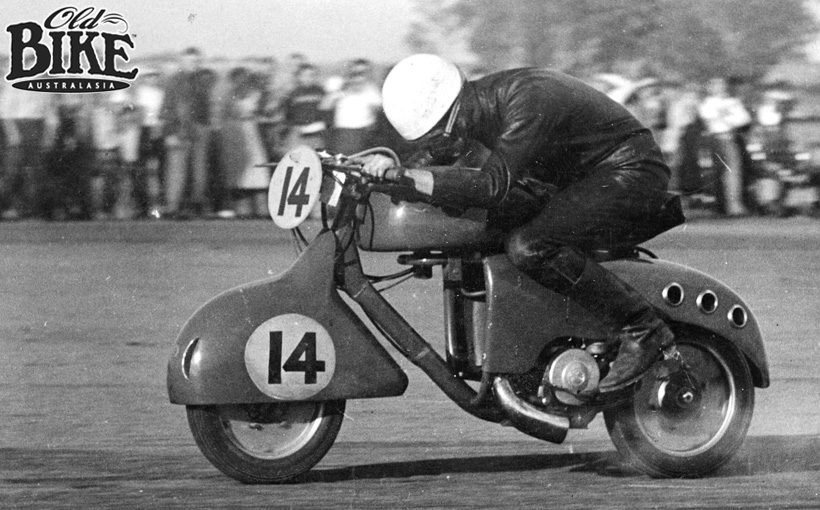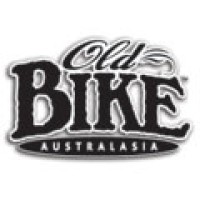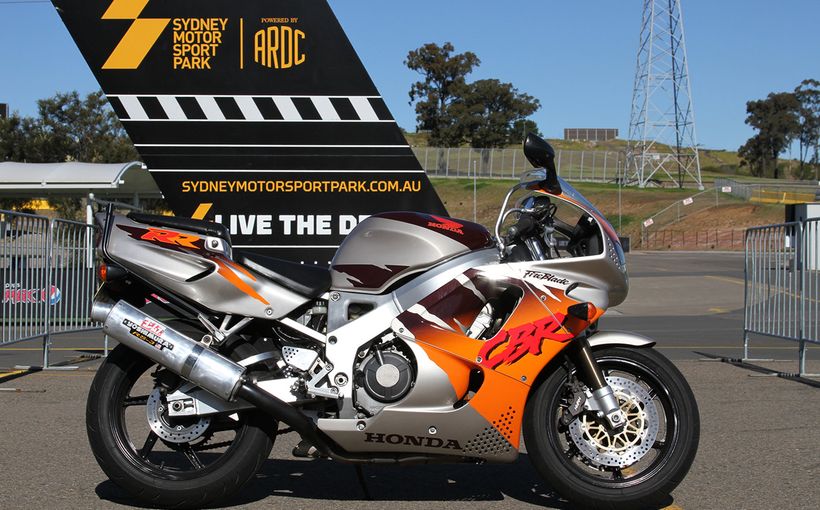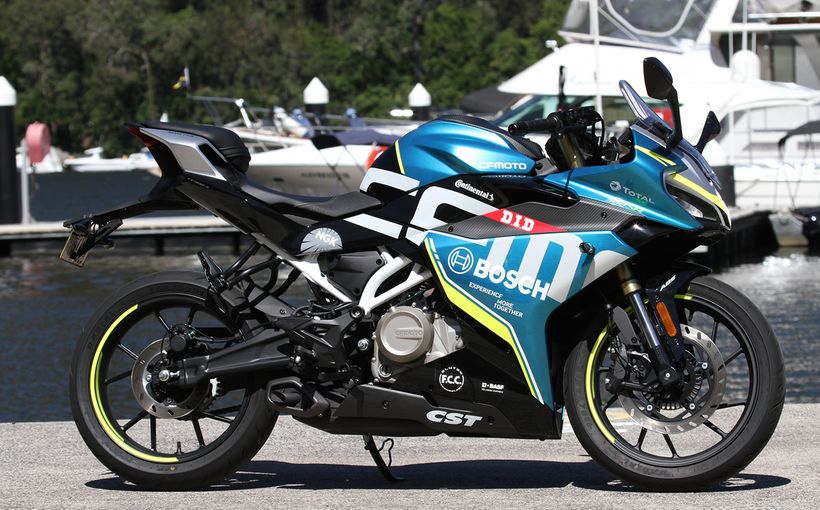
Like hundreds of other companies, Innocenti, founded in the 1920s by Fernando Innocenti primarily to produce seamless steel tubing, was faced with the massive task of rebuilding after WW2 and diversifying into whatever industry would turn a profit. The original drawings for a Lambretta scooter were the work of Cesare Pallavicino in 1944, but shortages due to the war meant the concept stayed just that for several years. Despite shortages of coal, electricity and most other raw materials, production began in 1947 with a target of 150 scooters a day. The name chosen was Lambretta, derived from the Lambro, a small river that ran near the factory.

By 1949, a new model, the B, was in production, and this set the scene for the brand’s success. Although still using the M Model engine and transmission, the B Model incorporated a new trailing-link front suspension, sprung rear end, 8-inch instead of 7-inch wheels, and a gear change operated by a twistgrip instead of a foot change. The B’s rear suspension came in the form of coil spring dampers mounted horizontally under the engine and a knuckle joint with spring suspension at the rear hub. The front suspension had the rubber bands replaced by a pair of springs in the front forks.
Within a year another new model appeared, the Model C, with a 125cc engine, and this in turn was superseded by the D (1952) and the cheaper E (1953). To promote the brand, Innocenti built a record breaker based on a Model C, which was gradually developed to produce 9.6 kW (13 hp) at 8,800 rpm in ‘supercharged’ form, using a volumetric compressor – more than triple the scooter’s original output. In early 1949, a four-rider team arrived at the banked Montlhery circuit in France and established a new 24-hour world record, covering 2,467 kilometres at an average speed of 102.8 km/h. 18 months later, Dario Ambrosini (1950 250cc world champion on a Benelli) set new 125cc class records of 132 km/h for six-hour, twelve-hour and 1,000 km marks. Finally, in 1951, Remolo Ferri piloted the Lambretta to an incredible 200.7 km/h for the flying kilometre and 201.8 km/h for the flying mile on the Munich-Ingolstadt Autobahn.
With their eye on export markets, Innocenti sent out feelers in all directions, including Australia. A race-prepared Lambretta scooter found its way to these shores, imported by Bendigo motel owner Jack Walters; this had the A-series motor and transmission housing without the knuckle joint rear hub. It was generally referred to a B-Series racer because of the enclosed front mudguard and general appearance, and was campaigned initially in Victoria by Fane Iles and later by Bert Flood took over the reins, and in October 1951 scored a win at the South Australian Jubilee TT at Woodside.
In Sydney, ‘Big Sam’ Jamieson, through his company Australian National Motors, began importing Lambretta (and other Innocenti products), and to publicise the brand, arranged to bring in two pukka C-Model racers, for the princely sum of £500 each! This would have bought a new Manx Norton at the time (had one been available), but the two machines came with a considerable quantity of spare parts, including four different diff ratios, spare wheels and Mahle pistons, carburettors and exhausts tuned for either petrol or alcohol fuel. Jamieson went the whole hog, fitting out a bright red sign-written double-bike trailer to travel to the races, and engaging the services of quick (and light weight) riders Bob Jemison and Keith Conley. To be offered a ride on a genuine works racer wasn’t something that happened every day, and Jemison was sceptical, but on November 15th, 1951 the Lambrettas duly arrived, and were presented to the media at a special function at the company’s premises in Sydney, attended by the Italian Commercial Attache and the president of the Italian Chamber of Commerce, as well as several top riders and trade representatives.

The two Lambrettas differed greatly from the road-going models, having special frames with a large diameter front down tube that swept rearwards at 45º and under the engine, where it met the twin smaller diameter top frame tubes. A fat jelly-bean shaped alloy fuel tank sat atop the dual top tubes, which finished in a loop, short of the steering head. A single shock absorber was attached on the right rear of the transmission tunnel, which housed the shaft drive. The actual rear springing was by a torsion bar located under the engine. Front suspension was by an un-damped spring unit mounted on the trailing link forks. Alloy wheels with finned brake drums were fitted with 12-inch Pirelli racing tyres from the special batch made for the European record attempts. The gearbox contained four ratios with a foot change, and theoretically the clutch was only needed to start the machine, whereafter gears could be changed without the clutch. A 28 mm Dell’Orto carburettor fed the mixture. Officially, the Lambrettas, engine numbers 4S and 5S were designated Monotubo (single exhaust), and had been converted from the Bitubo (twin exhaust) racers ridden for the factory by Romolo Ferri and Alfredo Copeta. The single-port iron barrel had a single piston-controlled transfer port, while the crankshaft, con-rod and big end assembly and drive shaft were all made by the Swiss armaments factory, Oerliken.

Accompanying the scooters was an official factory mechanic, Renato Been, or ‘Beenie’ as he became known. Been insisted in running the bikes on a very rich mixture, which ensured easy starting and complete reliability, even at the expense of higher revs and hence, higher top speed.
For the 1952 season the Lambrettas performed fairly well, winning several events at Mount Druitt and taking Jemison to second place at Bathurst. At the end of the 1953 season Bob Jemison retired from racing, and Keith Conley moved on to bigger machines, so Sam Jamieson offered the Lambrettas to the Hinton brothers, Eric and Harry Jnr. On alcohol, the engines were operating on 9:1 compression, but the Hintons progressively raised this to around 15:1, although with a dramatic drop in reliability – melted pistons were not uncommon. However when the engines stayed together they were fast – top revs increasing to over 8,000 which equated to 115 mph (185 km/h) on the tallest gearing. Eric Hinton was especially critical of the gearbox, describing it as “having about forty neutrals and four forward gears”. The Hintons persevered with the Lambrettas for little more than twelve months before handing them back to Jamieson, and nothing was seen of them for several years. Eventually the Lambretta agency, and the two racers, passed to Hazell & Moore in Campbell Street, Sydney. The racers were consigned to a corner of Hazell & Moore’s workshops in Surry Hills, and were basically forgotten.

Around 1956, Kevin Roydon, who had a large motorcycle business at Lakemba in western Sydney, bought both Lambrettas. They were rebuilt with help from the redoubtable ‘Nooge’ Smith, who made aluminium fairings and a smaller fuel tank for the 4S bike, which hung through the top frame rails. Both bikes had extra tubing attached to the top frame rails, connecting the steering head to the loop under the fuel tank. The standout result achieved in this period was Kel Carruthers’ second place in the 125 cc Australia TT at Phillip Island in December 1957. Roydon eventually disposed of the pair, and around 1960, Ron Black and his mate Ron Bastick made an offer of forty pounds for one of the bikes which was accepted, and Black raced it at Orange and at Bathurst in 1960, 61 and 62, although with no real success.
Engine number 4S eventually went to Joe Shannon, and it is still owned by his son Peter. Over the years the streamlined aluminium covers for the front and rear wheels of both machines have disappeared, although Peter’s machine still has the small tank and aluminium dolphin-style fairing made by Nooge Smith. Peter Shannon has plans to have the original wheel fairings recreated. Peter’s machine owes its very existence to quick intervention by his late father, Joe. “My brother Mark and I were going to cut it up to make a mini bike, “ Peter recalls a little sheepishly. “We had the hacksaw out ready to cut up the frame when dad intervened and stopped us!”

As for Lambretta itself, a combination of the labour strife that crippled Italy in the 1960s, and bad management finally brought the Innocenti company to its knees in 1972. The motor car side was sold to British Leyland, while the scooter business and the Milan factory was acquired by the Indian government. Scooters India Ltd began producing Innocenti’s final design, the GP 150, but production ceased altogether in 1998. Nowadays, vintage scooters are highly collectable, and none more so than this pair of rare mini racers.
Protect your Lambretta. Call Shannons Insurance on 13 46 46 to get a quote today.










